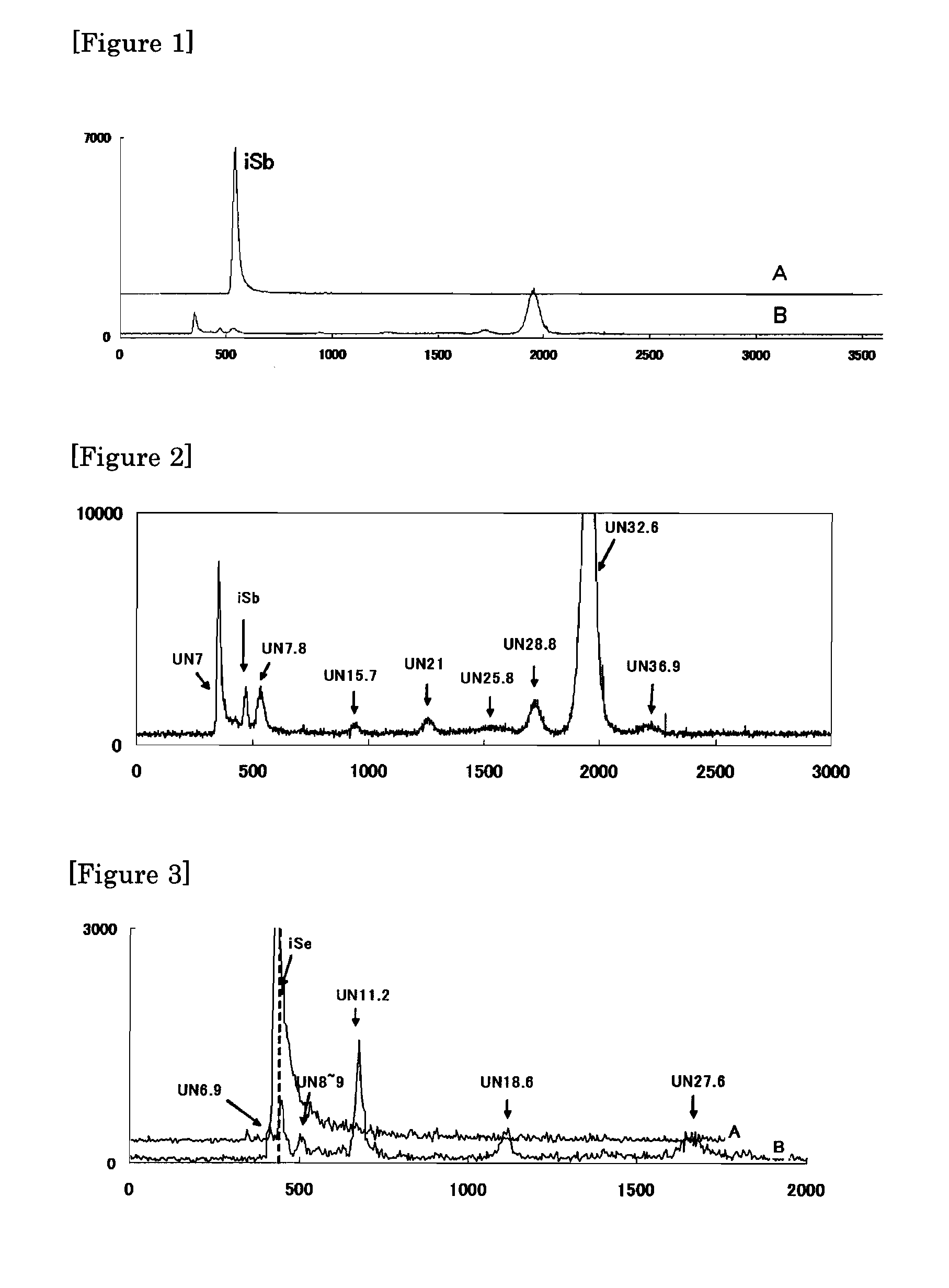Method of detoxifying a harmful compound
a technology of harmful compounds and detoxification methods, applied in the direction of physical/chemical process catalysts, metal/metal-oxide/metal-hydroxide catalysts, chemistry apparatuses and processes, etc., can solve the problem of difficult mass disposal, and achieve the effect of reducing harmful inorganic arseni
- Summary
- Abstract
- Description
- Claims
- Application Information
AI Technical Summary
Benefits of technology
Problems solved by technology
Method used
Image
Examples
example 1
Detoxification of the Inorganic Arsenic
[0041]0.5 mL of 1 ppm arsenic trioxide standard solution (Hereinafter, it gives iAs(III)), 7.7 mL of an ultrapure water (18MΩ / cm), and 1.8 mL of acetic acid (superhigh grade, hereinafter, it gives AA) were mixed (Solution A). As a catalyst, titanium oxide, cerium hydroxide, an absorbent for heavy metal (Nippon Sheet Glass Company Limited, Adosera, hereinafter, it gives AD) were prepared. As to titanium oxide, TiO2 (A) (ACROS, an anatase-type) and TiO2 (RA91) (Kishida Chemical Co., Ltd, 90% of a rutile type+10% of an anatase-type) were prepared. As to cerium hydroxide, ceric hydroxide (JUNSEI CHEMICAL CO., LTD.) were prepared. 2 mg (1.5 mmol) of methylcobalamin was solved with 1 mL of an ultrapure water, further, this was diluted hundredfold by adding an ultrapure water (Solution B). 1.5 mg of cyanocobalamin was solved with 1 mL of an ultrapure water, further, this was diluted hundredfold by adding an ultrapure water (Solution C). 1.5 mg of hydr...
example 2
Detoxification of Antimony
[0048]Next, antimony was also examined instead of arsenic. Specifically, solution E which is those of the use of the inorganic antimony (iSb (IV)) instead of iAs (III) of the solution A used in the Example 1, was prepared, and the reaction was carried out under the conditions shown in Table 4. Moreover, the condition of No. 18 is the same condition as No. 2-2 of the Table 2, the condition of No. 19 is the same condition as No. 17-2 of the Table 3. The HPLC-ICP-MS chromatograms before and after the reaction are shown in the FIGS. 1 and 2.
TABLE 4exposure to lightReaction solutionCatalystLightTimeNo.(μL)Catalyst(mg)Source(hr)18Solution E1000TiO2(RA91)100UV-A119Solution E1000—0UV-C1
[0049]FIG. 1 gives a HPLC-ICP-MS chromatogram of the methylation reaction as to the inorganic antimony. (A: Before the reaction, B: After the reaction) [A methyl source: AA, A light source: UV-A, A photocatalyst: TiO2 (RA91)] A vertical axis: intensity (cps), A horizontal axis: time ...
example 3
Detoxification of Selenium
[0051]Next, selenium was also examined instead of arsenic, antimony. Specifically, solution F which is those of the use of the inorganic selenium (iSe) instead of iAs (III) of the solution A used in the Example 1, was prepared, and the reaction was carried out under the conditions shown in the Table 5. The HPLC-ICP-MS chromatograms before and after the reaction are shown in the FIG. 3.
TABLE 5exposure to lightReaction solutionCatalystLightTimeNo.(μL)Catalyst(mg)Source(hr)20Solution F1000TiO2(RA91)100UV-C1
[0052]FIG. 3 gives a HPLC-ICP-MS chromatogram of the methylation reaction as to the inorganic selenium (A: Before the reaction, B: After the reaction) [A methyl source: AA, A light source: UV-C, A photocatalyst TiO2 (RA91)]. A vertical axis: intensity (cps), A horizontal axis: time (second).
[0053]A of the FIG. 3 is a chromatogram before the reaction, B of the FIG. 3 is a chromatogram after the reaction of No. 20. Although there was only a peak of iSe before ...
PUM
| Property | Measurement | Unit |
|---|---|---|
| oxidation-reduction potential | aaaaa | aaaaa |
| wavelength | aaaaa | aaaaa |
| wavelength | aaaaa | aaaaa |
Abstract
Description
Claims
Application Information
 Login to View More
Login to View More - R&D
- Intellectual Property
- Life Sciences
- Materials
- Tech Scout
- Unparalleled Data Quality
- Higher Quality Content
- 60% Fewer Hallucinations
Browse by: Latest US Patents, China's latest patents, Technical Efficacy Thesaurus, Application Domain, Technology Topic, Popular Technical Reports.
© 2025 PatSnap. All rights reserved.Legal|Privacy policy|Modern Slavery Act Transparency Statement|Sitemap|About US| Contact US: help@patsnap.com

